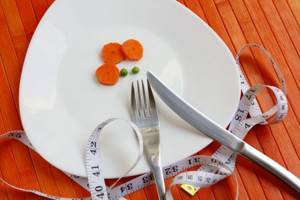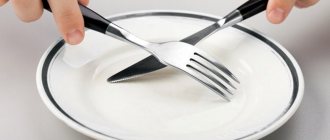Problems Caused by Fasting
Fasting is not always safe, so before choosing this diet, you need to become familiar with a number of problems that may arise during this strict diet and after.
- With prolonged hunger, health problems may arise, such as dizziness, weakness, nausea, and irritation.
- If you end a long fast incorrectly, serious stomach problems can occur, as well as a sharp increase in weight.
- Since a long absence of food is stress for the body, the consequences of such fasting can be different. All this is individual.
- The lack of nutrients in the body leads to a slowdown in metabolism, which in turn affects a decrease in immunity.
- First of all, water leaves, and only then fat is burned. Without physical activity, a person on any diet will lose weight.
Not all fasting can be healthy
Before going on a long fast, you should consult with a specialist and undergo all the necessary tests, otherwise the risk of ruining your health will increase significantly.
Having learned about all the dangers of fasting, it is worth moving on to practice.
Types of therapeutic hunger

In many articles, their authors repeat: “Fasting is a natural process.” And a paragraph later they add: “refusing food is stress for the body.” I don't know how these two postulates fit together. Stress has never been the norm, and the word “thin” does not mean “healthy.”
But perhaps it’s time for your overweight carcass to shake yourself up and suffer for the sake of a good goal - gaining a beautiful, slender figure.
If so, let's go!
Main types of fasting
So, fasting is divided into two types: dry and water. People who choose to fast usually want to lose weight, but don't know where to start. Below you will find details on how to fast to lose weight.
Dry fasting
Cascade fasting
With this type of hunger, you can’t not only eat any food, but you also can’t drink water or have any contact with it at all. But under such conditions, fasting should usually not exceed more than 3 days. And it is better to carry it out not at home, but under the supervision of specialists, since this method can be very dangerous to health.
Benefits of dry fasting:
- in such a famine, the result will not take long to arrive;
- the body rejuvenates;
- dry fasting is a quick way to cleanse the body;
- There is almost no feeling of hunger.
Important! It is much more difficult to stay on such a strict diet.
Water fasting
This type is a little simpler, since it is easier to fast on water. The body will not have to endure the lack of water, which is so vital for humans. The only difference here is that the duration of such fasting is from 1 week to several months.
For your information! Most often, water fasting is used for weight loss.
The advantages of this method of losing excess weight:
- relative simplicity;
- immunity improves;
- internal cleansing of the body is carried out, which in turn leads to rejuvenation.

There are several ways to fast for weight loss
What will happen to your body if you fast for 3, 7, 21 and 40 days?
Today, the so-called water healing fasting is very popular, the essence of which is to completely refuse food and consume exclusively liquids (water).
Attitudes towards fasting are quite controversial. Many doctors are inclined to believe that hunger is a serious stress for the body, which can have an extremely negative impact not only on the physical, but also on the mental state of a person.
Adherents of therapeutic fasting, on the contrary, claim that this is an effective way to cleanse and rejuvenate the body, normalize the functioning of the gastrointestinal tract, and increase muscle tone.
Well, let's look at what external and internal changes fasting for 3, 7, 21 and 40 days will lead to.
Fasting 3 days
A three-day fast is considered the mildest and safest option for cleansing the body of waste and toxins.
On the first day of fasting
You should not expect significant changes in the body. Of course, you will feel hungry, but the supply of nutrients and energy is quite enough to not only overcome the desire to eat at least something, but also to complete daily tasks.
To relieve hunger and feel good, it is recommended to drink 250 ml of water every hour on the first day of fasting.
On the second day of fasting
, which is better to start with a glass of water and a morning walk, your vigor will undoubtedly decrease, and the feeling of hunger will clearly make itself felt. In addition, you may feel very thirsty. You can drink up to 2.5 liters of water per day.
Third day of fasting
will be marked by the appearance of nausea, weakness, unpleasant taste in the mouth, white coating on the tongue (in people with problematic health, the coating can be yellow, gray and even brown). Water will help relieve the above symptoms somewhat.
According to those who endured such a three-day fasting marathon (and not everyone can do this), the following changes occurred in their body:
- The body has been cleansed of toxins, waste and mucus.
- Excess fluid came out, resulting in swelling of the legs, arms and face.
- I managed to lose 1 to 3 kg of excess weight.
- The functioning of the gastrointestinal tract has normalized.
- Pain sensations (especially in the joints) have decreased significantly.
- The condition of the musculoskeletal system has improved.
Let's be objective and voice the negative consequences of a three-day fast, because of which many abandon this idea, fearing for their health.
- Tachycardia (increased heart rate to 120 - 140 beats per minute) and bradycardia (decreased heart rate below 60 beats per minute).
- Nausea and dizziness.
- Daytime sleepiness.
- Fast fatiguability.
- Irritability and aggressiveness.
- Headache.
Similar manifestations can appear both on the first and third days of fasting.
Types of fasting
These types vary in duration.
Intermittent or cyclical fasting
Fasting for 3 days
The meaning of such short-term fasting is in cycles. For some time a person does not eat anything, but at some intervals he can allow himself to eat some foods. There are different schemes. For example, 16:8 - 16 hours of fasting and 8 hours of regular eating. Or 20:4, where there are 20 hours of fasting and 4 hours of regular nutrition. Such interval nutrition can hardly be called a diet, since it is more of a lifestyle, because you can eat according to such schemes for several months or years. Many nutritionists consider this the most effective for those who are planning to lose weight. If you also perform additional physical exercises, the results will be doubly surprising.
Cascade fasting
Here the days alternate, not the hours. For example, 1 day of fasting and 1 day of regular eating. There may be more complex schemes, for example, 3 weeks of fasting and 5 weeks of regular eating. This method may be more difficult, but for some it is more convenient. The benefits are the same as any other type of fasting.
Note! Some nutritionists advise using enemas and laxatives during long fasts.
Cosmo recommends
Fashionable haircut 2020 for thin hair - long bob: styling methods
Who repeats: star children and their parents with the same beauty techniques
The essence of intermittent fasting is that you fast for 16 hours a day, and the rest of the time (you have 8 hours left!) you can eat whatever you want. At your disposal are buns, cakes, burgers, breaded wings, potatoes... That is, if you have breakfast at 9 am, then your last meal (it can be pizza, pasta or steak) should be before 5 pm. At the same time, it is worth understanding that if you do not limit yourself to fast food and soda, then this diet is unlikely to work. So be smart!
Nutritionist Ksenia Selezneva believes that such a nutrition system is very effective, but is not suitable for everyone. For example, if a girl has problems with the gastrointestinal tract (gastritis or peptic ulcer), then she should not take such long breaks between meals. And one more thing: the first meal after a 16-hour break should be the most satisfying, calorie content should decrease by the end of the day.
Out of habit, you may feel hungry (16 hours is no joke!). To overcome it and not break down, we recommend drinking green tea or a glass of water.
In general, you should do intermittent fasting for no more than two weeks. In just three days, the extra pounds will begin to fall off, and as a result, you can lose up to 5 kg. Although the same doctors do not prohibit following such a diet for several months - provided that the body reacts positively to long breaks in food. If, in addition to a feeling of lightness and a surge of strength, you feel dizzy and weak, then it is better to postpone the hunger strike and eat something healthy, for example, a green apple.
By the way, there are contraindications for intermittent fasting. If you are under 18 years old, if you are pregnant or nursing a child, if you have diabetes or gout, then this diet is not for you. In general, before you start experimenting with food, you need to consult your doctor.
You should come out of fasting very carefully: you should not throw yourself on fatty, heavy foods. Otherwise, everything unnecessary will immediately return to its place. Gradually reduce the time intervals between meals, and add easily digestible foods to your diet: salads, pureed soups, vegetables and fruits.
In addition to the fact that during intermittent fasting, the body takes energy through the breakdown of fats (thanks to this you quickly lose weight), detoxification (cleansing) also occurs, concentration improves, and blood sugar and cholesterol levels decrease. And that's great!
How much can you lose by fasting for weight loss?
One-day fasting
The figures for weight lost vary depending on the characteristics of the body, the type of fasting and the duration. On average, a person loses from 1 to 2 kg in the first days of hunger. But this is not fat, but excess water. In 1 to 2 weeks of fasting, a person can lose approximately 8 kg. If the period exceeds 2 weeks, then this is minus 10 kg or all 15. Every day the body will lose less and less weight during fasting. But all these numbers are the result of people using water fasting to lose weight. But how much weight can you lose on dry fasting? In this case, in the first days 2 or more kilograms are lost. Longer dry fasting can cause harm to the body.
Water during intermittent (intermittent) fasting for 48 hours.
The most important thing is loading with two types of liquid.
The first is medicinal mineral water, additionally carbonated. It is good for the kidneys, for the liver, for the joints, it has strong mineralization (10-15 g), but it cannot be drunk constantly. About 200 ml in the first half of the day, before 12:00 - 13:00. Often this water is sold in glass bottles or bioplastic. Some plastic bottles even contain the recommended dose for: - taking - for example, no more than 0.5 liters per day. Also pay attention to whether this or that water is indicated for children, pregnant and lactating women. This mineral water is good for liver detox and detox of the entire digestive system. It is also worth paying attention to water saturated with Magnesium - such as Donat Mg - If you have problems with sleep, and this is very common, especially during the first long fasts - take a bottle of this water for the first stage of “mineralization” of your body - and you will great sleep, and bonus, great colon cleanse. In addition, hunger itself affects the detox of the body and cleanses the skin perfectly: the longer the fast, the better the effect.
Secondly, we will need water with a neutral mineral composition, which is recommended for drinking every day. This natural water is enriched with minerals and can be drunk in unlimited quantities. Mineral composition – up to approximately 3-5 g/l.
In the evening, you need to drink chamomile tea to neutralize the removal of excess bile, to reduce acidity, calms the gastrointestinal tract, prevents bloating, works great for detoxing the body. And, of course, chamomile has sedative properties, so it should be drunk in the evenings during long fasts.
You can also drink freshly ground coffee without additives on the first day of a long fast.
During long fasts, we maintain our usual minimum activity of 10,000 steps. Strength exercises, if you have them, leave them. Avoid stress to avoid gluttons. And, of course, attitude is important! You do not lose, but gain - you get to know your body! It’s very cool to let the body cope with insulin resistance, to let the body cope with working on subcutaneous fat.
How to fast to lose weight
Everyone knows what hunger is, but not everyone knows how to fast properly to lose weight. It's very simple - you need to go through 3 stages, each of which is important in the process of losing weight through fasting.
- Entrance. It will be difficult for an unaccustomed person to last several days without food if he does not carry out preliminary preparation. But how to start fasting to lose weight? Preparation consists of reducing food intake. First, all harmful foods are eliminated from the diet: sweets and starchy foods. Further, meat is excluded. And during this stage, portions should decrease every day, which is necessary to narrow the stomach. Further, not only portions are reduced, but also meals. So gradually, without sudden jumps, you can switch to hunger without severe stress for the body.
- Hunger. At this stage, you need to drink more water, be distracted and not forget about your goal.
- Exit. You should not rush into food after a long or even three-day fast. This can lead to disruption of the gastrointestinal tract. Since during fasting the stomach rests and relaxes, it cannot be frightened by heavy food, it is not ready for it. If in this case there are no problems with the gastrointestinal tract, which is unlikely, then the weight will definitely return.

The hardest thing about fasting is getting out of this diet correctly.
Exit from two days of fat burning fasting.
You can open up after a 48-hour fast with a huge number of foods. The main thing is that these are delicate foods such as fish, omelettes, stewed or raw vegetables that do not irritate the stomach with their acidity. Eat food slowly, every 15-30 minutes. On this day, try not to eat heavy foods such as red meat, nuts, and it is advisable not to eat fast carbohydrates at all, because your blood is completely cleared of sugar and increased insulin.
Raven’s recipe for breaking a 48-hour hunger (don’t forget, Raven is a man, he’s pumping, his base metabolism is elevated):
20:00 Glass of water + juice of 2 lemons
20:30 Snack of 700 kcal - 100 g cheese and apple
21:00 Vegetable salad + cheese + chicken breast 1500-1600 kcal
Step-by-step return to normal nutrition
The first days you can drink juices, then whatever you want. Next comes liquid porridge. Gradually you can add light lean soups and vegetables and fruits. On the 14th day you can eat as usual.
For your information! On the Internet, you can find a home fasting plan that is convenient for you, or you can create one yourself, scheduling everything by day.
After hunger, it is better to switch to proper nutrition so as not to gain excess weight. Fasting can be used as an eraser to clear the slate for a new life. And it works in much the same way, because during fasting the entire body is cleansed at the cellular level. The longer the fast, the deeper the cleansing will be.
Afterword

No one denies that if you adjust your diet, then fasting for weight loss will not be in vain and you will maintain the results for many years. But here’s the question: is hunger necessary at all if you adjust your diet and start eating right?
Perhaps I’ll remind you of the good news: you can use my “Active Weight Loss Course ,” which is now available anywhere, just turn on the Internet. I will share with you how to lose weight without fasting and dieting, while getting rid of many years of deposits of your own fat, becoming healthier and enjoying life.
I also hasten to inform you that my Course will be updated with new materials, in addition, you can always contact me and ask your questions. I managed to lose 50 kilograms and I will be happy to share with you how to achieve this. Don't lose optimism - and everything will work out!
That's all for today. Thank you for reading my post to the end. Share this article with your friends. Subscribe to my blog. And let's move on!
A Detailed Guide to a 3-Day Dry and Water Fast
One-day fasting
If you decide to resort to the technique, then it is best to start at a time when the maximum load on the body is. There is even a calendar according to zodiac signs, which indicates the best day to start the process. For example, Saturday is most suitable for Capricorn and Aquarius, and Thursday is the day of Pisces and Sagittarius; Tuesday – Aries, Scorpio; Friday – Taurus and Libra; Monday – Cancer; Wednesday – Gemini and Virgo; Sunday – Leo. It is believed that if you follow this calendar, it will not only be easier to be in this process, but it will also be much easier for the body to get out of it.
How should you fast? It’s simple, you need to prepare psychologically for this process in advance. After a person is ready, he gets up in the morning and does not eat or drink anything. Dry hunger is quite difficult to withstand, so many people resort to drinking liquid. The liquid should only be water. You cannot drink coffee, tea or other drinks.
The solution should be gradual, you need to start it by drinking fruit juice for breakfast, eating a banana for lunch, juice again for an afternoon snack, but in the evening you can have a salad. Portions should be small, and you won’t be able to eat a large amount at one time, since the stomach will be quite tight.

Features and results of three-day fasting











